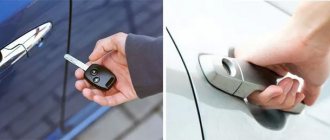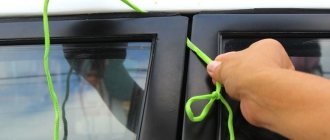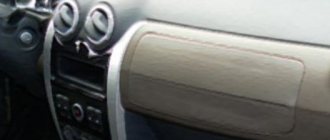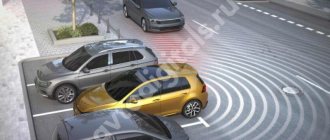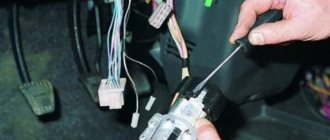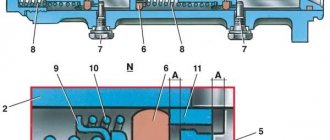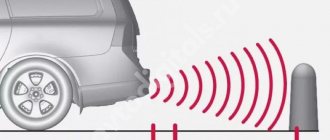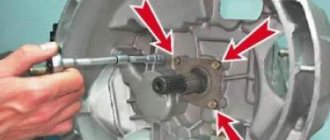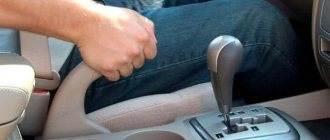Hello, friends! Any motorist can get into an accident or become involved in an accident. This does not depend 100% on experience, skills, and the ability to make quick decisions in difficult situations. Interestingly, reversing out of a parking lot often causes a collision.
The number of accidents in parking lots and parking lots is impressive. At the same time, when faced with a collision on a regular road, drivers usually know how to act. If the situation occurs in a parking lot (parking lot), then the participants are lost.
Distances are short, there are many vehicles. It's hard to keep track of everything going on around you. According to statistics, it is when you back out of a parking lot that the largest number of accidents occur.
Where to begin
When reversing onto the roadway, or into an area not occupied by cars, the driver may get into an accident.
In general, the words road accident, reversing and who is to blame are heard very often on various thematic forums and websites.
The parking lot isn't the only place where this happens. You can drive backwards into someone in the yard, in the parking lot, as well as in parking lots and other areas with limited space for a safe turn.
If you find yourself in such a situation, you must:
- don't start panicking;
- stop to prevent further damage;
- turn on the emergency lights;
- put an emergency sign on the road;
- if there are victims, call an ambulance;
- call the traffic police squad.
Practice, as well as the rules for leaving a parking lot in reverse, show that in most cases the driver of a vehicle moving in reverse gear is at fault. This is due to the fact that when maneuvering, the motorist must first make sure that the action being performed is safe.
Where parallel parking skills are needed
This method of parking is a helper in conditions of urban use and an acute shortage of free space. The ability to park the car correctly allows you to take a seat even in conditions of limited space.
In addition, parallel parking is one of the mandatory exercises when passing your license (we wrote about this above).
What are the rules?
Now you need to understand the rules that apply to leaving the parking lot. To be more precise, this is leaving a parking lot in reverse.
Drivers have the following chain: leaving the parking lot - accident - who is to blame.
The current rules say that driving in reverse gear is permitted in a situation where the maneuver is safe and will not create problems for other road users.
But if an accident occurs in a parking lot, who is to blame? The one who was driving back.
Yes, other drivers, as well as road users, can potentially be held accountable. For example, if the second car was speeding. But even here, both drivers will be held accountable.
It is important to take into account that an accident does not provide any relief in the event that the motorist who made a reverse collision or created an emergency situation was prevented by factors beyond his control. For example, bad weather or low visibility due to insufficient street lighting.
Correct adjustment of car mirrors
Before parking when reversing, you should first learn how to adjust the mirrors. Everyone sets it up differently. Some people deliberately lower the mirror to observe part of the rear wheel. This allows you to avoid accidental collisions with various obstacles.
It is ideal if each mirror is adjusted. In the mirror located in the cabin, the entire rear window with its lower edge should be visible, and in the side mirrors - the part of the body behind and the surrounding environment.
How to act
For some motorists, getting out of the parking lot onto the road causes certain difficulties.
There are some useful recommendations in this regard:
- if you cannot assess the situation on your own when leaving, ask for help from a passenger or a random passer-by;
- the help of another person will allow you to drive out safely and also give signals to other drivers;
- It’s better not to back up if the weather is bad;
- It is also not recommended to engage reverse gear when there is low visibility outside.
But there is also a universal recommendation that helps quite often.
Yes, it is important to understand that parking arrangements do not always allow this.
But objectively, the best solution would be to park in such a way that when leaving, the driver is required to drive forward. In other words, you should park in reverse. This will allow you to drive forward, in forward gear, and thereby minimize the likelihood of a collision with other road users in the parking area.
How to reverse out of a parking lot between cars correctly
We are practicing a skill that a car owner cannot do without in the urban jungle. But it’s a little different from what they teach in driving school.
Many drivers without experience panic when they find themselves in such situations. After all, by the time you get out of the “grip,” you’ll sweat seven times so as not to inadvertently hit some kind of car. And, as luck would have it, there are “millionaires’ cars” all around.
Of course, if you prepare at the very beginning and drive into a parking space backwards, then getting out will be much easier: the entire view is open, and you won’t need much room for maneuvers. But there is not always time for such actions, and it is more convenient to unload shopping bags when the car is parked in the trunk to leave.
In this case, you need to thoroughly master the skill of driving backwards and practice it until you perform it confidently.
In a driving school they teach you to first drive as far back as possible, and only then start turning the steering wheel and setting the angle of rotation. But this way you practically leave yourself no room for action and can “hook” all your neighbors. It is better to immediately rebuild into a more advantageous position.
Review of Eurodetal car boxes: characteristics, owner reviews
As many motorists probably know, driving in reverse according to the current rules is prohibited if it:
- crossroads;
- bridge;
- tunnel;
- crosswalk;
- railroad crossing;
- bus stop;
- area with poor visibility;
- highway.
As you can see, there is no question of parking here. And this is quite logical.
Punishment follows only if the driver’s actions in reverse led to a collision, as well as the need to register an accident. This can be done using the European protocol if the amount of damage is less than 100 thousand rubles. Or you will need to call the police.
According to the current rules, for violations of the rules of maneuvering, which specifically includes driving backwards from a parking lot, the culprit driver is forced to pay only 500 rubles.
It’s just important to take into account the fact that it will cover the cost of repairing the damaged car.
Recommendations from experts and current life hacks
The advice may seem simple and banal. But in practice, they help a lot, and also allow you to better navigate situations and make correct and thoughtful decisions.
- Do not hurry. The advice “not to rush” is one of the simplest. But for urban conditions it plays a key role. Be aware not only of other cars and pedestrians, but also of signs, signs and markers. Don't take the first available spot if the pocket seems too narrow. Drive through the parking lot and find another option. Take the time and fuel to practice.
- Control the situation around you. It’s great when no one is walking around the parking lot, there are no cars honking behind you, and there are no gazes on your actions. But in real conditions it is almost impossible to achieve this. If you can't stop quickly after occupying a parking space, look for another pocket. Try not to interfere with other drivers. But if someone persistently honks, although you have just begun the maneuver, try to abstract yourself and focus on completing your task.
- Check the serviceability of headlights and lighting fixtures. Make sure the light comes on when you engage reverse gear. Check the operation of the dimensions, as well as the emergency lights. Turn them on so other drivers understand your intentions.
- Remember responsibility. The driver is responsible for what he does on the roads, parking lots and parking lots. If you don’t yet know how to park properly, then you shouldn’t leave your car haphazardly. Alternatively, find a vacant lot that doesn't require such complex maneuvers to park. Even if the place is far away.
- Try not to worry too much. Worries and worries definitely won’t help you when parking perpendicularly. You are neither the first nor the last to learn new maneuvers. And certainly not the first one to fail at something. You need to study and practice. There is no need to worry, worry or be nervous. If the maneuver fails, repeat it several times during training, watch some useful videos. No one is stopping you from going to a driving school to brush up on some skills.
- Don't be overconfident. You should not be surprised by the fact that experienced drivers with extensive experience can get into accidents and accidents. The thing is that they stop paying attention to the little things that beginners usually focus on. There is nothing wrong with self-confidence. For a driver, this is even a good quality. But when it turns into overconfidence, that's when problems begin.
This is not to say that perpendicular parking is an incredibly difficult maneuver to perform in a car. But you need to learn this and always remain as focused as possible. Regardless of your skills, experience and credentials as a professional driver. Absolutely anyone can make mistakes.
How often do you stop in perpendicular parking? How difficult is this maneuver for you? Do you prefer to park in front or behind? Have you ever had an accident in a parking lot? Who was to blame?
A couple of tips for a snack
When parking behind a car, do not forget to leave enough free space in front of you to freely leave the parking lot if it is not possible to reverse. Strictly ensure that you maintain a distance from nearby cars when parking crosswise! The most optimal distance between neighboring cars should be equal to the width required for free opening of the driver or passenger door of the car. Otherwise, opening the door may damage a car parked next door. Be careful when approaching the edge of the sidewalk. Lack of proper distance between it and your car can cause it to hit the curb or other nearby objects.
We hope that the above material will allow you to more quickly master the skill of proper parking. The absence of haste and fear will serve you well in this difficult task and will allow you to easily and easily cope with any complex maneuver.
Traffic rules when parking backwards
In the traffic rules, reversing is mentioned in paragraph 8.12.
It states that such a maneuver is permitted subject to two conditions:
- The maneuver will be safe (that is, it will not be dangerous for other persons participating in the movement).
- No interference is created for traffic participants.
It would be useful to have the help of a third party to correct the movement. This could be a passenger present in the car, a citizen passing by or another driver nearby.
The assistant will be able to coordinate the movement of vehicles backing up and give a signal that there are no passing cars or other obstacles.
This method is especially suitable for a beginner.
More experienced drivers can perform the maneuver perfectly using the mirrors.
In a collision with other cars, the culprit will be the driver who hit the bumper of another car.
The likelihood of an accident occurring not only during parking, but also at the moment of leaving when reversing (in a parking lot, near a supermarket).
A driver parking a vehicle in reverse is required to:
- Immediately stop the car when an assistant gives a sign or the sound signal of another car. It would be much more reasonable to go out and look around, spending a minute or two, than to then file an accident, call a car service and resolve controversial issues with the insurance company.
- When leaving, you need to use every rearview mirror. Alternately estimate the distance in each of them.
- If a car is moving between vehicles, you need to look carefully on both sides. Make sure that no one is driving neighboring cars, and that no one nearby is performing the same maneuver.
- Since emergency situations usually arise during the exit, it is recommended to initially park in reverse. Thus, even if a person is in a hurry, he will already leave in a straight line.
If you violate the rules of maneuvering, you may be fined under Article 12.14 of the Code of Administrative Offences. The article provides for a fine of up to 500 rubles.
Learning direct parking
This is a very simple and necessary method in the city. Here the car is parked along something in a straight line. If you decide to park this way, you don't need to drive too close to the objects in front of you.
Also don't forget about the doors. Pay attention to obstacles near your doors. When parking straight ahead, approach the car in front of you as close as possible to 1.5 m. Then start moving towards the curb.
Before the front wheels reach the curb 0.5 m, turn the car to the left. Then level off. This requires precise control skills. Focus on the dimensions of the car in front of you.
Also consider safe departure.
Difference between stopping and parking
According to paragraph 1.2 of the Russian Traffic Regulations, the law distinguishes between stopping and parking. For example, if you stop driving for up to 5 minutes (or more if necessary to board or disembark passengers or load or unload a vehicle), it is considered a stop. If the cessation of movement occurs for more than 5 minutes for reasons not related to boarding/disembarking or loading/unloading of the car, then this is considered parking.
See also: This is why you can’t park in guest pockets in courtyards
“
Stop ” is a deliberate stop in the movement of a vehicle for up to 5 minutes, as well as for longer if this is necessary for boarding or disembarking passengers or loading or unloading a vehicle. “ Parking ” is the intentional cessation of movement of a vehicle for a period of more than 5 minutes for reasons not related to the embarkation or disembarkation of passengers or the loading or unloading of the vehicle.
